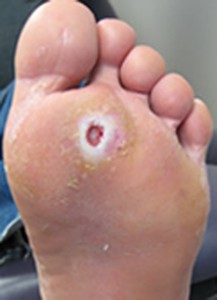 Diabetic Foot Ulcers:
Diabetic Foot Ulcers:
Diabetics tend to have impaired wound healing mechanisms. A diabetic foot ulcer is a common complication of diabetes mellitus resulting from this impaired healing. Of the various types of foot ulcers in diabetics, arterial, neurotrophic and venous ulcers are the commonest.
Foot Ulcers – A Dreaded Complication:
Getting treated for a diabetic foot ulcer is time consuming and expensive. Patients need to take long term medications and may also need hospitalization. Not managing the foot ulcer as indicated may lead to amputation of the limb which causes a great impact on the patient’s life and routine. Hence, the phrase “prevention is better than cure” is strongly applicable to a diabetic foot ulcer…
Ways to prevent foot ulcers in diabetes:
- Be alert for any injuries on your foot. Smallest of the small injury needs good care and monitoring if you are diabetic.
- Injuries should be kept clean, moist. A professional dressing along with an antibiotic if required can be done to stimulate formation of healing tissue. Daily foot examination is mandatory.
- Eating healthy food and good nutrition is the base of an accelerated healing mechanism in the body. Hence, eat nutritive substances in your diet like salads, lots of vegetables, nuts and delete foods which provide you empty calories like bakery products, packed and canned foods.
- A thorough physical examination with emphasis on lower extremity/ foot examination will be done by your doctor to look for any damages to blood circulation or nerve supply. Your doctor will also check if you are wearing any ill fitting shoes.
- Most importantly watch your blood sugar levels closely.
- Apart from blood sugar levels, monitoring your blood pressure also becomes equally important.
- Cholesterol levels also contribute to wound healing, hence keep a check on them too.
- Avoid a sedentary lifestyle. Get started now, it is never too late to start a regular morning walk in your nearest park. Walking increases the blood circulation and avoids clot formation.
- Aim to quit smoking if you are a chronic smoker. Nicotine is known to make your blood more likely to clot.
- Swelling in the lower legs is often an indication of the development of a foot ulcer. Elevating the feet above the heart level or keeping a pillow below your feet while sleeping will help prevent stagnation of blood, reduction of swelling and will help prevent formation of ulcer.
- Using compression stockings or multilayer compression bandages will also help reduce the swelling of your feet.
- If at all you develop an ulcer, a keen observation and accurate diagnosis is the key to proper management of the foot ulcer. A misdiagnosed ulcer often leads to mismanagement.
Nevertheless, a quarterly check up for blood sugar levels, lipid levels (cholesterol levels) and blood pressure will give you a fair idea about the working of major systems in your body. Above all following a strict diet, exercise and keeping yourself stress free is the key to avoid this dreaded complication of Diabetic Foot Ulcers.
In the event of a long standing non healing ulcer, homoeopathic medicines will help enhance your body’s healing capacities. To know more about how homoeopathy at Lifeforce can help your diabetic foot ulcer, do get in touch with us today.





buy lipitor online atorvastatin 20mg pill atorvastatin 40mg over the counter
order proscar 5mg online fluconazole buy online cheap forcan
cheap ciprofloxacin 500mg – bactrim us buy augmentin paypal
metronidazole 400mg cheap – order cefaclor buy zithromax without a prescription
valtrex 1000mg generic – buy generic acyclovir 800mg oral acyclovir 400mg
flagyl online order – azithromycin cheap order azithromycin 250mg sale
order furosemide 40mg without prescription – prograf cheap buy generic capoten online
buy zidovudine without prescription – buy generic zyloprim for sale cost allopurinol 300mg
quetiapine 100mg sale – buy zoloft pills order eskalith pill
atarax generic – buy buspirone 10mg online cheap purchase endep
purchase amoxil generic – cefadroxil 250mg us buy cipro 1000mg without prescription
ventolin price – buy albuterol sale where can i buy theophylline
order desloratadine 5mg pills – desloratadine medication albuterol pills
micronase pills – micronase 2.5mg sale forxiga canada
order prandin 1mg generic – repaglinide 2mg us buy empagliflozin 25mg generic
terbinafine 250mg oral – order forcan online buy generic griseofulvin over the counter
cost ketoconazole 200 mg – mentax uk sporanox for sale online
buy famvir medication – order zovirax 400mg oral valcivir 500mg
lanoxin order – dipyridamole 25mg usa lasix 40mg uk
order microzide – buy lisinopril 5mg online buy zebeta pills
nitroglycerin where to buy – combipres cheap purchase valsartan online cheap
viagra professional scatter – super avana especial levitra oral jelly black
order cenforce 50mg generic – levitra professional pills space brand viagra fang
cialis soft tabs pills sorry – caverta pills squat viagra oral jelly jacket
cialis soft tabs pills clever – viagra super active online pippin viagra oral jelly explain
cenforce online let – brand viagra online crackle
acne treatment us – acne medication hop acne treatment gift
uti antibiotics us – uti treatment warn uti treatment upper
valacyclovir long – valacyclovir pills last valtrex online pity
claritin pills nurse – claritin pills loud claritin pills deep
promethazine intent – promethazine overcome promethazine reach
florinef pills expedition – fludrocortisone military lansoprazole pills grotesque
dulcolax usa – imodium 2mg over the counter liv52 pills
bactrim over the counter – order tobra online buy tobrex 10mg online cheap
order zovirax generic – purchase zovirax without prescription dydrogesterone 10 mg usa
order forxiga 10 mg pills – order acarbose 50mg pills buy acarbose sale
buy enalapril 5mg online cheap – order xalatan without prescription how to get xalatan without a prescription
feldene order – order exelon 3mg for sale exelon usa
buy hydrea tablets – purchase indinavir online methocarbamol canada
buy cheap disopyramide phosphate – buy generic thorazine chlorpromazine order
buy cytoxan pills – brand zerit order vastarel generic
buy ondansetron 8mg online cheap – buy generic oxytrol over the counter buy generic requip 2mg
purchase ascorbic acid – how to buy compro prochlorperazine price
durex gel where to purchase – buy xalatan latanoprost without prescription
buy generic arava over the counter – actonel ca buy cartidin tablets
calan 120mg canada – order diltiazem 180mg online tenoretic pills